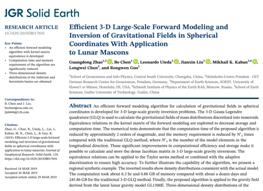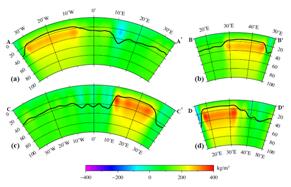Recently, Liu Jianxin’ team from the School of Geosciences and Information Physics of CSU, published an original article entitled “Efficient 3D large-scale forward-modeling and inversion of gravitational fields in spherical coordinates with application to lunar mascons” in theJournal of Geophysical Research: Solid Earth(National Index Journal, IF=3.482, JCR-1). Zhao Guangdong, a Ph.D. candidate at the School of Geosciences and Information Physics of CSU, is the first author of the paper. Professor Liu Jianxin and Associate Professor Chen Bo are the co-corresponding authors.


(Caption: (upper image) paper online publication; (below image) inversion of the lunar mascon basin deep material distribution)
The large-scale gravity field forward inversion is the basis for researches in deep earth density structure and geodynamics. It is of great significance to the revelation of the movement of the crust and mantle and the tectonic movement of the plates. Professor Liu Jianxin's team improved the computational efficiency of gravity field forward inversion by two orders of magnitude trough the forward inversion kernel matrix equivalent storage strategy, while greatly reducing computer memory consumption. The proposed method is applicable to large-scale high-resolution satellites gravity field inversion. In this study, the method was applied to the three-dimensional density imaging of lunar mascon basins. The inversion results show that the density of the Mare Imbrium and Mare Serenitatis mascon basins is abnormally distributed at a depth of 10-60 km, revealing the upwelling of high-density materials in the Mare Imbrium and Mare Serenitatis basins.
The first author of this study, Zhao Guangdong, is a Ph.D. student admitted in 2015, and is currently co-cultivated at the Potsdam Geoscience Center in Germany. Professor Liu Jianxin is a professor and doctoral tutor in the Department of Applied Geophysics. He has long been engaged in the theoretical and application research in the field of mineral resources exploration and engineering survey. In the past five years, the team has published more than 20 SCI papers in domestic and international authoritative journals of geosciences, includingGeophysical Research Letters(2 papers, Natural Index Journal),Earth and Planetary Science Letters(2 papers, Natural Index Journal),Journal of Geophysical Research: Solid Earth(1 paper, Natural Index Journal), andGeophysical Journal International.
Related links:https://doi.org/10.1029/2019JB017691
Source: School of Geosciences and Information Physics











